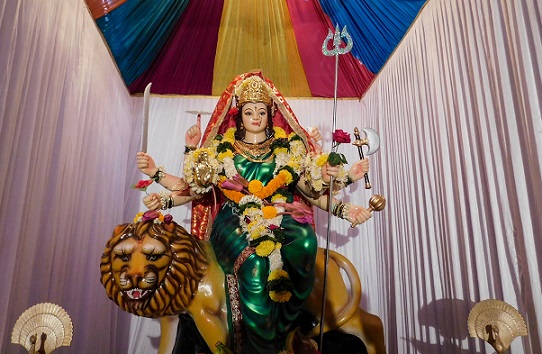Navaratri Festival
The word “Navaratri” is originated from the Sanskrit word ‘Nava’ which means ‘Nine’ and ‘Ratri’ means ‘Night’. It has been observed as one of the prominent festivals of Hindu and is celebrated across India, especially in the northern region of the country.
Four Navratri in a year
Generally, there are four Navaratri in a year i.e., Chaitra Navaratri (March-April), Ashada Navaratri, Sharad Navaratri (September-October), and Magha Navaratri but among these Chaitra and Sharad have been the most commonly celebrated by the Hindu religion.
Navratri Celebration
In this festival people worship the goddess “Durga” over the nine nights and ten days. Along with the worshiping goddess, people also have fast and eat only fruits, nuts, and vegetables (strictly avoid grains). Many of you think why people have fast to worship the goddess? So, as per religious beliefs, Navaratri is celebrated as the victory of goddess “Durga” over the Buffalo demon “Mahishasur” and helps to restore the “Dharma” but as per scientific claims Navaratri is celebrated to allow our body to adopt a new season and maintain the healthy lifestyle.
Science behind the Navratri Fasting
Now, after knowing this you may be further curious to know if it provides health benefits then why do people have fast only the Chaitra and Sharad Navaratri besides having four? Again, the scientific explanation for celebrating only these two Navaratri is: that these two months are playing the role of weather changing season. In Chaitra month winter ended and summer started and in Sharad month summer is about to sum up and winter begins. So, Hindu religion’s people have fast for nine days to make the coordination in his fooding style and weather fluctuations because if people directly change the fooding pattern immediately, then it will negatively affect their health. Knowing the health benefit of fasting at changing season, the similar fasting culture is also performed by Muslim religion i.e., Ramadan (at the beginning of Summer).
Nine days of Navratri and its significance
Each day of Navaratri is being worshiped as different role of goddess Durga. Lets see in details;
1st Day of Navratri (Pratipada)
Pratipada (first day) is associated with goddess “Shailaputri” (Daughter of Mountain) is an incarnation of “Parvati” (Wife of Shiva); she is depicted as sitting on Nandi (Bull) with trishula in her right hand and lotus in left hand. Shailaputri is also incarnation of Sati (First wife of Shiva) and also known as Hemavati.
2nd Day of Navratri (Dwitiya)
Dwitiya (second day), Goddess Brahmacharini, is another incarnation of Parvati’s Yogini role (unmarried), she is worshiped for the emancipation of moksha and endowment of peace and prosperity. She is depicted as walking with holding “Kamandala” (pot) and “Japamala” (rosary). She symbolizes bliss and calm.
3rd Day of Navratri (Tritiya)
Tritiya (third day) celebrates to worship “Chandraghanta” (Ardha-Chandra adorned on her forehead) is another incarnation of Parvati after marrying with Shiva.
4th Day of Navratri (Charturthi)
Chaturthi (fourth day) is celebrated to worship goddess Kushmanda. She is believing the source of creating universe and associated with endowing the vegetation of earth.
5th Day of Navratri (Panchami)
Panchami (fifth day) is worship to Skandamata. Skanda is name of Kartikeya, hence his mother named as Skandamata. She is depicted as riding a ferocious lion and holding Kartikeya.
6th Day of Navratri (Shasthi)
Shasthi (sixth day) is celebrated to goddess “Katyayani”. She is the warrior goddess and represents the form of Parvati, Mahalaxmi and Mahasaraswati.
7th Day of Navratri (Saptami)
Saptami (seventh day) is celebrated to worship goddess “Kalaratri”. She is another incarnation of Parvati and killed the demons Sumbha and Nisumbha.
8th Day of Navratri (Ashtami)
Ashtami (eighth day) is commemorating to worship the goddess “Mahagauri”.
9th Day of Navratri (Mahanavami)
Mahanavami (ninth day) is observed to worship the goddess “Siddhiratri”. She is possessing and bestowed all types of siddhis. Shiddhiratri is also seen as the “Ardhanarishvara’ form of half body of both Shiva and Shakti. Mahanavmi of Chaitra Navaratri is also celebrated as the birth of lord “Rama” in northern region of India.
So, Navaratri is fully associated with Hindu religion for praying the various form of the goddess “Durga”. It teaches us to fight against adharma/demons to restore the dharma. People also learn to have fast to keep ourself mentally, physically healthy and achieve enlightenment while performing the Navaratri culture.






















0 Comments